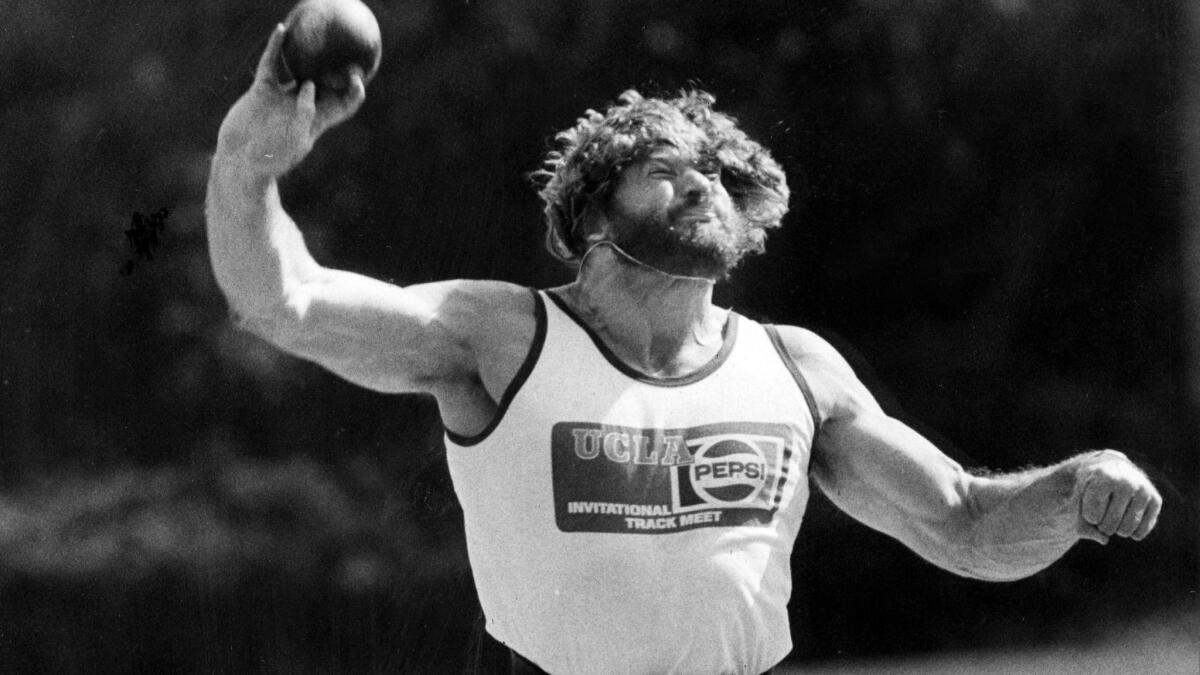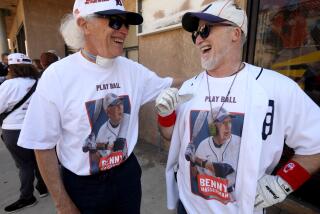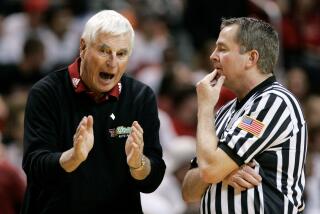Brian Oldfield, free-spirited Olympian who excelled at shot putting and partying, dies at 71

One cigarette was all it took.
Brian Oldfield, a young shot putter on the U.S. team at the 1972 Summer Olympics, was dying for a smoke so he borrowed a match and lit up a Lucky Strike.
Smack dab in the middle of the competition. Between throws. In front of an international television audience.
Just that quickly, Oldfield established himself as a free spirit whose whirling style revolutionized the shot put but whose talents were frequently outshone by a penchant for partying, wearing outlandish clothes and bucking tradition.
It was a reputation that would grow as he set a string of records, appeared on “The Superstars” television show and dabbled in boxing. It would stick with him until his death over the weekend at 71.
“It doesn’t seem fair that of all the things I picked to be the best in the world at — I mean, who wants to be a shot putter?” he once told The Times. “We’re the dummies, hardly leading-men types.”
Born June 1, 1945, Oldfield grew up in Elgin, Ill., and excelled as a high school athlete before attending Middle Tennessee State, where coaches noticed something special about him.
For a man standing 6-5 and weighing almost 300 pounds, he possessed uncanny athleticism.
“He could run, jump and make you shake your head at some of the things he could do,” Dean Hayes, the school’s longtime track coach, said in a statement Monday.
Oldfield used that agility to approach his sport in a new way. Whereas shot putters had traditionally shuffled — or “glided” — across the ring, he generated ferocious momentum by gyrating in tight circles.
Others may have experimented with this technique, but Oldfield was the first to make it work.
“I’m revolutionizing the sport by spinning in discus style,” he would later explain.
It was a paradigm shift, like Dick Fosbury changing the high jump by “flopping” backward over the bar. But Oldfield’s radical technique wasn’t the only thing that got him noticed.
After college, he qualified for the 1972 Olympic Games wearing swim trunks and a fishnet tank top. That summer in Munich, he puffed his way to a sixth-place finish, then soon turned pro by joining the nascent International Track Assn.
Track was different back then — still clinging desperately to its “amateur” image — so officials viewed the new breed of professionals as renegades.
In 1975, Oldfield put the shot 75 feet at a meet in El Paso, surpassing the world record by more than 3 feet. His performance went ignored by the record books.
Not that he seemed perturbed.
“No one can touch me unless they adopt that style,” he said at the time. “And right now I’m miles ahead of everyone else.”
His unofficial record earned him a spot on Sports Illustrated’s cover. That same year, he appeared in Playgirl magazine.
“Brian loved being the center of attention,” said Al Franken, a longtime track promoter in Southern California. “He loved to entertain and he had a terrific personality.”
Normal track uniforms did not suit him; Oldfield preferred bright colors and skimpy, Speedo-like shorts. “A circus outfit,” Franken called it. He wore his hair in an often unruly mop.
Like him or not, track could not ignore his success as competitors quickly adopted that spinning technique, which remains dominant to this day.
Oldfield credited the motion with allowing him to remain an elite athlete over two decades. At 38, after regaining his amateur status, he threw nearly 73 feet, a mark that track officials recognized as an American record.
Ultimately, his meandering career would include a sparring session with Muhammad Ali, an erstwhile try at wrestling and a role as Mongo the drug lord in the 1989 film “They Call Me Macho Woman.”
Oldfield also competed in “The Superstars” and ”World’s Strongest Man” TV competitions and in the Scottish Highland Games.
“I’m a perpetual dreamer,” he told The Times in 1980. “The truth is, I’ve been bankrupt more than anything else all these years.”
A lifetime of competing — and celebrating — at breakneck pace ultimately restricted him to a wheelchair. His website announced his death on Sunday, but did not list a cause.
“He was a dominant force,” Franken said. “Certainly one of the all-time greats.”
More to Read
Start your day right
Sign up for Essential California for the L.A. Times biggest news, features and recommendations in your inbox six days a week.
You may occasionally receive promotional content from the Los Angeles Times.







